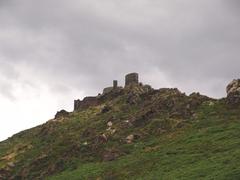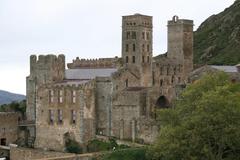Dolmen De La Casa Cremada: Visiting Hours, Tickets, and Roses Historical Sites Guide
Date: 14/06/2025
Introduction
Nestled in the rugged hills near Roses, in Catalonia’s Alt Empordà region, the Dolmen de la Casa Cremada and its neighboring menhirs stand as remarkable vestiges of prehistoric ingenuity and ritual. Dating back approximately 5,000 years to the late Neolithic and early Bronze Age (circa 3000 BCE), these megalithic monuments reveal the social, spiritual, and cultural practices of the region’s earliest agrarian communities (Empordà Turisme; visitroses.cat).
The Dolmen de la Casa Cremada, a corridor tomb built from sturdy gneiss slabs, and nearby menhirs such as Menhir de la Casa Cremada, offer invaluable insight into the area’s prehistoric funerary rites and territorial markers. Today, these monuments are freely accessible, forming a key part of the Roses Megalithic Complex—one of Catalonia’s most significant archaeological landscapes. This guide provides detailed information on the site’s history, cultural significance, visitor logistics, and practical tips to ensure an enriching experience.
Table of Contents
- Historical Overview and Chronology
- Site Description and Archaeological Context
- Ritual and Cultural Significance
- Visiting Hours, Tickets, and Accessibility
- Roses Megalithic Heritage: Key Monuments and Routes
- Visitor Experience: Practical Tips and On-Site Information
- Nearby Attractions and Combinations
- Conservation and Preservation
- Frequently Asked Questions (FAQ)
- Visual Gallery
- References and Further Reading
Historical Overview and Chronology
Origins of the Dolmen and Menhirs
The Dolmen de la Casa Cremada and its associated menhirs date from the late Neolithic to early Bronze Age (circa 3000 BCE). This was a time of significant transformation in the Iberian Peninsula: agriculture flourished, community life became more complex, and monumental stone structures emerged as focal points for ritual and social organization (Empordà Turisme).
The menhir, discovered toppled with its base broken, was re-erected in 1999 during a community event. This act of revival underscores local dedication to preserving their ancient heritage.
Site Description and Archaeological Context
Dolmen de la Casa Cremada
- Type: Corridor tomb with a trapezoidal chamber, originally covered by a stone mound.
- Material: Constructed from locally sourced gneiss slabs.
- Remains: Only two slabs remain upright, with other stones scattered around the site. The original form is inferred from comparisons with similar monuments (visitroses.cat).
Menhir de la Casa Cremada
- Description: Standing stone, over 2 meters tall, characteristic of menhirs found across Western Europe.
- Function: Likely served as a territorial marker or ceremonial point. Its elevation offers sweeping views, reinforcing its landmark role (Empordà Turisme).
Broader Megalithic Context
The site forms part of a megalithic cluster in the Pla de la Casa Cremada, which includes corridor tombs, cists, and menhirs. These monuments reflect a sophisticated relationship between communities and their landscape (Roses.net).
Ritual and Cultural Significance
Megalithic monuments like the Dolmen de la Casa Cremada are interpreted as expressions of collective memory, ancestor veneration, territorial control, and cosmological beliefs. Their construction demanded coordinated community effort and shared ritual understanding. Menhirs may have marked boundaries, commemorated events, or acted as focal points for gatherings, while dolmens served as communal burial sites (sortirambnens.com).
Visiting Hours, Tickets, and Accessibility
Access and Opening Hours
- Dolmen de la Casa Cremada: Open-access site, free of charge, with no official visiting hours. Accessible year-round, 24/7 (visit.roses.cat).
- Menhir de la Casa Cremada: Also accessible at all times; best visited during daylight for safety and optimal appreciation (Empordà Turisme).
Getting There
Located just outside Roses, the site is reached via the road toward Cala Montjoi and Cadaqués. There is a small car park and trail signage, though a GPS map is recommended for precise navigation (visitacostabrava.com).
Accessibility
- Terrain: Natural, uneven ground; not wheelchair accessible.
- Families: Manageable for children with care; strollers not suitable.
- Facilities: No restrooms or cafés on-site. Amenities are available in Roses (visit.roses.cat).
Roses Megalithic Heritage: Key Monuments and Routes
Main Archaeological Highlights
- Dolmen de la Creu d’en Cobertella: Largest dolmen in Catalonia, featuring seven massive stones (visitroses.cat).
- Dolmen del Llit de la Generala: Corridor tomb with partial restoration.
- Dolmen del Cap de l’Home: Short trapezoidal chamber; notable for Neolithic artifacts.
- Menhir de la Casa Cremada I & II: Gneiss monoliths with distinctive features.
- Rec de la Quarentena Dolmen-Caves: Unique dolmens utilizing natural rock shelters.
- Necrópolis del Puig Alt: Late Bronze Age cemetery with cremation burials (radiocadena.es).
Themed Routes
- Megalithic and Dry Stone Itinerary I: 4.4 km circular route, moderate difficulty; showcases Casa Cremada and other monuments.
- Itinerary II & III: Extend exploration through the Montjoi valley and forested areas, integrating more sites and natural scenery (visitroses.cat).
All routes are well marked, but signage can be subtle. Digital maps or GPS tracks are highly recommended (nobedtimesnoborders.com).
Visitor Experience: Practical Tips and On-Site Information
Best Time to Visit
- Spring and Autumn: Ideal for mild weather and lush surroundings.
- Summer: Possible, but can be hot with minimal shade. Early morning or late afternoon is best (nobedtimesnoborders.com).
What to Bring
- Water, snacks, and sun protection (hat, sunscreen, sunglasses).
- Sturdy hiking shoes or boots.
- GPS/phone with pre-downloaded trail maps.
- Camera for panoramic views and stone monuments (nobedtimesnoborders.com).
Safety and Etiquette
- Stay on marked trails to protect both landscape and archaeological remains.
- Do not climb or sit on the stones.
- Carry out all litter and respect local flora and fauna.
Language and Signage
- On-site information is mostly in Catalan and Spanish. English resources are limited; translation apps may be helpful (nobedtimesnoborders.com).
Guided Tours
- Roses Tourist Office occasionally offers guided walks with expert commentary; check schedules in advance (visit.roses.cat).
Nearby Attractions and Combinations
- Espai Cultural Ciutadella: Museum in Roses with artifacts and exhibitions from the region’s prehistory (rosescultura.cat).
- Puig Rom Visigothic Castrum: Remains of a Visigothic fortress nearby.
- Roses Beaches and Cap de Creus Natural Park: Combine cultural and natural exploration for a full-day adventure (visitacostabrava.com).
Conservation and Preservation
Site Condition
The Dolmen de la Casa Cremada is fragile, with only two upright slabs remaining and the original mound gone due to erosion and human activity. The site is unprotected, so visitors must be mindful of their impact (sortirambnens.com).
Community Efforts
Local initiatives, such as the re-erection of the menhir, reflect strong community interest in heritage preservation. However, balancing public access with conservation remains an ongoing challenge.
Environmental Considerations
The area is prone to summer fire risk; always adhere to local advisories and avoid open flames (visitacostabrava.com).
Frequently Asked Questions (FAQ)
Q: What are the visiting hours for the Dolmen de la Casa Cremada?
A: The site is open-access and can be visited at any time, year-round. Daylight hours are recommended for safety (visit.roses.cat).
Q: Is there an entrance fee?
A: No, the site is free to visit.
Q: Are guided tours available?
A: Occasionally, the Roses Tourist Office organizes guided visits. Check their website for details.
Q: Is the site wheelchair accessible?
A: No, the natural terrain is uneven and not suitable for wheelchairs or strollers.
Q: Where can I park?
A: A small car park is available near the site; additional parking is nearby.
Q: Are there any facilities on-site?
A: No, there are no restrooms or cafés at the dolmen. Facilities are available in Roses.
Visual Gallery

The Menhir de la Casa Cremada, a prehistoric standing stone in Empordà.

Panoramic views from the site of the Menhir de la Casa Cremada.
References and Further Reading
- Empordà Turisme: Menhir de la Casa Cremada
- Visit Roses: Megalithic Complex
- Visita Costa Brava: Roses Megalithic Route
- Sortir amb Nens: Itineraris Megalítics
- Radiocadena: Archaeological Sites in Roses
Conclusion
The Dolmen de la Casa Cremada and its surrounding megalithic landscape provide a captivating window into Catalonia’s distant past. Free and open to all, these sites offer not only a profound historical experience but also a chance to immerse yourself in the scenic beauty of the Costa Brava. Whether you are a passionate archaeologist, a cultural traveler, or a family looking for a unique day out, the megalithic monuments of Roses are a must-see.
Prepare for your visit with proper supplies, respect the site’s fragility, and consider a guided tour for deeper insight. For the latest updates, interactive maps, and audio guides, consult the Roses Tourist Office and download the Audiala app.
Step into history, marvel at ancient ingenuity, and contribute to the preservation of this extraordinary heritage.
Sources:



